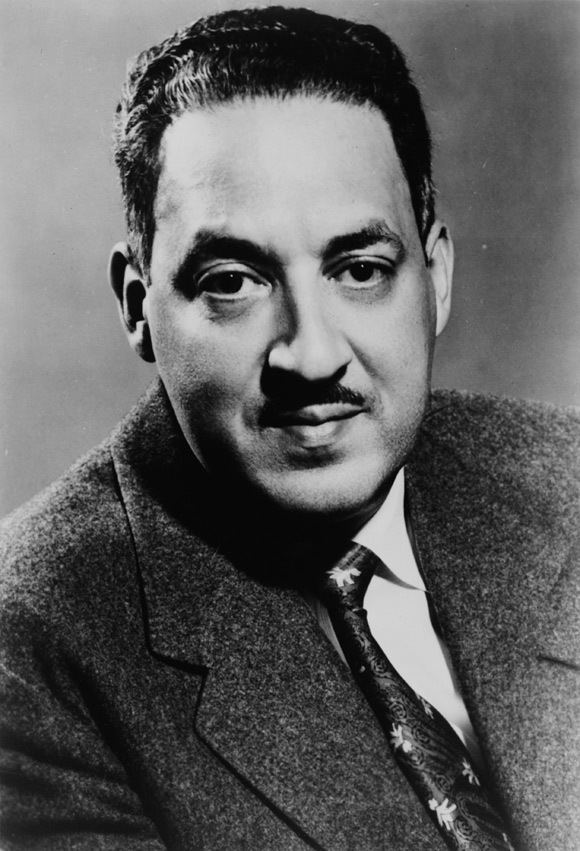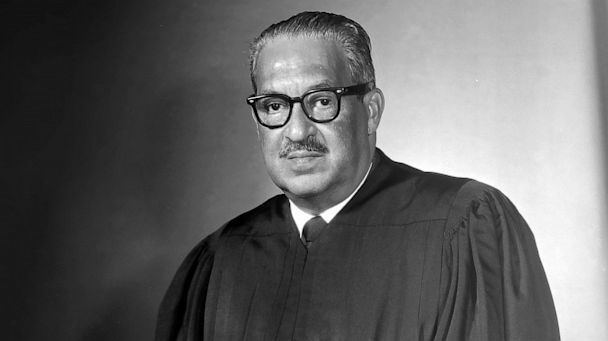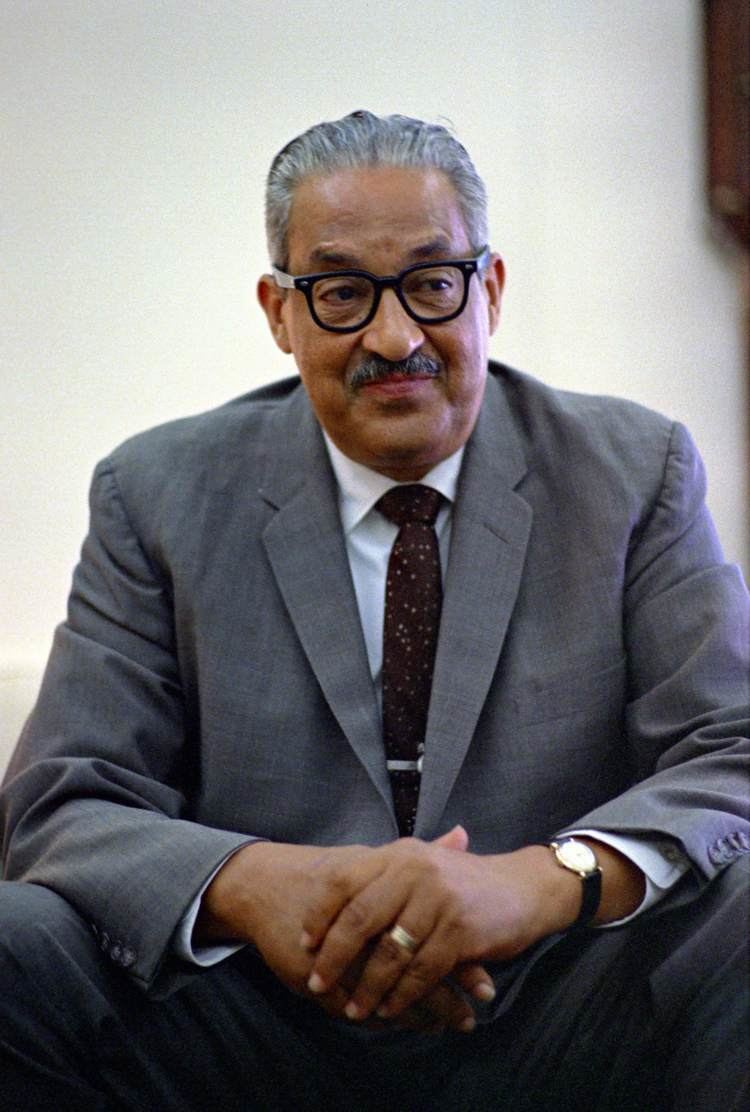Children Thurgood Marshall, Jr. President Lyndon B. Johnson | Name Thurgood Marshall Succeeded by Erwin N. Griswold | |
 | ||
Books Dream Makers, Dream Breakers: The World of Justice Similar People Clarence Thomas, Thurgood Marshall - Jr, William Rehnquist, Sandra Day O'Connor, William J Brennan - Jr | ||
Thurgood Marshall Confirmed as Supreme Court Justice - 1967 | Today in History | 30 Aug 16
Thurgood Marshall (July 2, 1908 – January 24, 1993) was an Associate Justice of the Supreme Court of the United States, serving from October 1967 until October 1991. Marshall was the Court's 96th justice and its first African-American justice. Prior to his judicial service, he successfully argued several cases before the Supreme Court, including Brown v. Board of Education.
Contents
- Thurgood Marshall Confirmed as Supreme Court Justice 1967 Today in History 30 Aug 16
- Supreme Court Justice Thurgood Marshall Preview
- Early life
- Law career
- Chief Counsel for the NAACP Legal Defense and Educational Fund
- Court of Appeals and Solicitor General
- US Supreme Court
- Death and legacy
- Marriage and family
- Thurgood Marshall Award
- Timeline
- In popular culture
- Books authored
- References

Born in Baltimore, Maryland, Marshall graduated from the Howard University School of Law in 1933. He established a private legal practice in Baltimore before founding the NAACP Legal Defense and Educational Fund, where he served as executive director. In that position, he argued several cases before the Supreme Court, including Smith v. Allwright, Shelley v. Kraemer, and Brown v. Board of Education, which held that racial segregation in public education is a violation of the Equal Protection Clause. In 1961, President John F. Kennedy appointed Marshall to United States Court of Appeals for the Second Circuit. Four years later, President Lyndon B. Johnson appointed Marshall as the United States Solicitor General. In 1967, Johnson successfully nominated Marshall to succeed retiring Associate Justice Tom C. Clark. Marshall retired during the administration of President George H. W. Bush, and was succeeded by Clarence Thomas.

Marshall was generally considered to be a liberal member of the Supreme Court. He wrote the majority opinion in cases such as Stanley v. Georgia, Bounds v. Smith, Personnel Administrator of Massachusetts v. Feeney, Teamsters v. Terry, and Cottage Savings Ass'n v. Commissioner. Notable cases in which he issued a dissenting opinion include Gregg v. Georgia, San Antonio Independent School District v. Rodriguez and City of Richmond v. J.A. Croson Co..

Supreme Court Justice Thurgood Marshall Preview
Early life
Marshall was born in Baltimore, Maryland, on July 2, 1908. One of his great-grandfathers was born in the modern-day Democratic Republic of the Congo, captured, and was taken to the United States as a slave; Marshall's paternal grandfather had also been enslaved. His original name was Thoroughgood, but he shortened it to Thurgood. His father, William Marshall, worked as a railroad porter, and his mother Norma, as a teacher; they instilled in him an appreciation for the United States Constitution and the rule of law.
Marshall attended Frederick Douglass High School in Baltimore and was placed in the class with the best students. He graduated a year early in 1925 with a B-grade average, and placed in the top third of the class. He went to Lincoln University. It is commonly reported that he intended to study medicine and become a dentist.
But according to his application to Lincoln University, Marshall said his goal was to become a lawyer. Among his classmates were poet Langston Hughes and musician Cab Calloway. Initially he did not take his studies seriously, and was suspended twice for hazing and pranks against fellow students. He was not politically active at first, becoming a "star" of the debating team.
In his freshman year he opposed the integration of African-American professors at the university. Hughes later described Marshall as "rough and ready, loud and wrong". In his second year Marshall participated in a sit-in protest against segregation at a local movie theater. In that year, he was initiated as a member of Alpha Phi Alpha, the first fraternity founded by and for blacks. His marriage to Vivien Burey in September 1929 encouraged him to take his studies seriously, and he graduated from Lincoln with honors (cum laude) Bachelor of Arts in Humanities, with a major in American literature and philosophy.
Marshall wanted to study in his hometown law school, the University of Maryland School of Law, but did not apply because of the school's segregation policy. Marshall instead attended Howard University School of Law, where he worked harder than he had at Lincoln and his views on discrimination were heavily influenced by the dean Charles Hamilton Houston. In 1933, he graduated first in his class at Howard.
Law career
After graduating from law school, Marshall started a private law practice in Baltimore. He began his 25-year affiliation with the National Association for the Advancement of Colored People (NAACP) in 1934 by representing the organization in the law school discrimination suit Murray v. Pearson. In 1936, Marshall became part of the national staff of the NAACP.
In Murray v. Pearson, Marshall represented Donald Gaines Murray, a black Amherst College graduate with excellent credentials, who was denied admission to the University of Maryland Law School because of its segregation policy. Black students in Maryland wanting to study law had to attend segregated establishments, Morgan College, the Princess Anne Academy, or out-of-state black institutions. Using the strategy developed by Nathan Margold, Marshall argued that Maryland's segregation policy violated the "separate but equal" doctrine of Plessy v. Ferguson because the state did not provide a comparable educational opportunity at a state-run black institution. The Maryland Court of Appeals ruled against the state of Maryland and its Attorney General, who represented the University of Maryland, stating, "Compliance with the Constitution cannot be deferred at the will of the state. Whatever system is adopted for legal education must furnish equality of treatment now."
Chief Counsel for the NAACP Legal Defense and Educational Fund
At the age of 32, Marshall won U.S. Supreme Court case Chambers v. Florida, 309 U.S. 227 (1940). That same year, he founded and became the executive director of the NAACP Legal Defense and Educational Fund. As the head of the Legal Defense Fund, he argued many other civil rights cases before the Supreme Court, most of them successfully, including Smith v. Allwright, 321 U.S. 649 (1944); Shelley v. Kraemer, 334 U.S. 1 (1948); Sweatt v. Painter, 339 U.S. 629 (1950); and McLaurin v. Oklahoma State Regents, 339 U.S. 637 (1950). His most famous case as a lawyer was Brown v. Board of Education of Topeka, 347 U.S. 483 (1954), the case in which the Supreme Court ruled that "separate but equal" public education, as established by Plessy v. Ferguson, was not applicable to public education because it could never be truly equal. In total, Marshall won 29 out of the 32 cases he argued before the Supreme Court.
During the 1950s, Thurgood Marshall developed a friendly relationship with J. Edgar Hoover, the director of the Federal Bureau of Investigation. In 1956, for example, he privately praised Hoover's campaign to discredit T.R.M. Howard, a maverick civil rights leader from Mississippi. During a national speaking tour, Howard criticized the FBI's failure to seriously investigate cases such as the 1955 killers of George W. Lee and Emmett Till. In a private letter to Hoover, Marshall "attacked Howard as a 'rugged individualist' who did not speak for the NAACP." Two years earlier Howard arranged for Marshall to deliver a well-received speech at a rally of his Regional Council of Negro Leadership in Mound Bayou, Mississippi only days before the Brown decision. According to historians David T. Beito and Linda Royster Beito, "Marshall's disdain for Howard was almost visceral. [He] 'disliked Howard's militant tone and maverick stance' and 'was well aware that Hoover's attack served to take the heat off the NAACP and provided opportunities for closer collaboration [between the NAACP and the FBI] in civil rights.'"
Court of Appeals and Solicitor General
President John F. Kennedy appointed Marshall to the United States Court of Appeals for the Second Circuit in 1961 to a new seat created on May 19, 1961, by 75 Stat. 80. A group of Senators from the South, led by Mississippi's James Eastland, held up his confirmation, so he served for the first several months under a recess appointment. Marshall remained on that court until 1965, when President Lyndon B. Johnson appointed him to be the United States Solicitor General, the first African American to hold the office. At the time, this made him the highest-ranking black government official in American history, surpassing Robert C. Weaver, Johnson's first secretary of housing and urban development. As Solicitor General, he won 14 out of the 19 cases that he argued for the government.
U.S. Supreme Court
On June 13, 1967, President Johnson nominated Marshall to the Supreme Court following the retirement of Justice Tom C. Clark, saying that this was "the right thing to do, the right time to do it, the right man and the right place." Marshall was confirmed as an Associate Justice by a Senate vote of 69–11 on August 30, 1967. He was the 96th person to hold the position, and the first African American.
Marshall once bluntly described his legal philosophy as this: "You do what you think is right and let the law catch up", a statement which his conservative detractors argued was a sign of his embracement of judicial activism.
Marshall served on the Court for the next 24 years, compiling a liberal record that included strong support for Constitutional protection of individual rights, especially the rights of criminal suspects against the government. His most frequent ally on the Court (the pair rarely voted at odds) was Justice William Brennan, who consistently joined him in supporting abortion rights and opposing the death penalty. Brennan and Marshall concluded in Furman v. Georgia that the death penalty was, in all circumstances, unconstitutional, and never accepted the legitimacy of Gregg v. Georgia, which ruled four years later that the death penalty was constitutional in some circumstances. Thereafter, Brennan or Marshall dissented from every denial of certiorari in a capital case and from every decision upholding a sentence of death.
In 1987, Marshall gave a controversial speech on the occasion of the bicentennial celebrations of the Constitution of the United States. Marshall stated:
The government they devised was defective from the start, requiring several amendments, a civil war, and major social transformations to attain the system of constitutional government and its respect for the freedoms and individual rights, we hold as fundamental today.
In conclusion Marshall stated:
Some may more quietly commemorate the suffering, struggle, and sacrifice that has triumphed over much of what was wrong with the original document, and observe the anniversary with hopes not realized and promises not fulfilled. I plan to celebrate the bicentennial of the Constitution as a living document, including the Bill of Rights and the other amendments protecting individual freedoms and human rights.
Although best remembered for jurisprudence in the fields of civil rights and criminal procedure, Marshall made significant contributions to other areas of the law as well. In Teamsters v. Terry, he held that the Seventh Amendment entitled the plaintiff to a jury trial in a suit against a labor union for breach of duty of fair representation. In TSC Industries, Inc. v. Northway, Inc., he articulated a formulation for the standard of materiality in United States securities law that is still applied and used today. In Cottage Savings Association v. Commissioner of Internal Revenue, he weighed in on the income tax consequences of the savings and loan crisis, permitting a savings and loan association to deduct a loss from an exchange of mortgage participation interests. In Personnel Administrator MA v. Feeney, Marshall wrote a dissent saying that a law that gave hiring preference to veterans over non-veterans was unconstitutional because of its inequitable impact on women.
Among his many law clerks were attorneys who went on to become judges themselves, such as Judge Douglas Ginsburg of the D.C. Circuit Court of Appeals; Judge Ralph Winter of the United States Court of Appeals for the Second Circuit; Supreme Court Justice Elena Kagan; as well as notable law professors Susan Low Bloch, Elizabeth Garrett (President of Cornell University), Paul Gewirtz, Dan Kahan, Randall L. Kennedy, Eben Moglen, Rick Pildes, Louis Michael Seidman, Cass Sunstein, and Mark Tushnet (editor of Thurgood Marshall: His Speeches, Writings, Arguments, Opinions and Reminiscences); and law school deans Paul Mahoney of University of Virginia School of Law, Martha Minow of Harvard Law School, and Richard Revesz of New York University School of Law.
Marshall retired from the Supreme Court in 1991 due to declining health. In his retirement press conference on June 28, 1991, he expressed his view that race should not be a factor in choosing his successor, and he denied circulating claims that he was retiring because of frustration or anger over the conservative direction in which the Court was heading." He was reportedly unhappy that it would fall to President George H. W. Bush to name his replacement. Bush nominated Clarence Thomas to replace Marshall.
Death and legacy
Marshall died of heart failure at the National Naval Medical Center in Bethesda, Maryland, at 2:58 pm on January 24, 1993, at the age of 84. He is buried in Arlington National Cemetery. His second wife and their two sons survived him.
Marshall left all his personal papers and notes to the Library of Congress. The Librarian of Congress, James H. Billington, opened Marshall's papers for immediate use by scholars, journalists and the public, insisting that this was Marshall's intent. The Marshall family and several of his close associates disputed this claim. The decision to make the documents public was supported by the American Library Association. A list of the archived manuscripts is available.
There are numerous memorials to Marshall. One, an eight-foot statue, stands in Lawyers Mall adjacent to the Maryland State House. The statue, dedicated on October 22, 1996, depicts Marshall as a young lawyer and is placed just a few feet away from where the Old Maryland Supreme Court Building stood; the court where Marshall argued discrimination cases leading up to the Brown decision. The primary office building for the federal court system, located on Capitol Hill in Washington D.C., is named in honor of Justice Marshall and contains a statue of him in the atrium. In 1976, Texas Southern University renamed its law school after the sitting justice. In 1980, the University of Maryland School of Law opened a new library which it named the Thurgood Marshall Law Library. In 2000, the historic Twelfth Street YMCA Building located in the Shaw neighborhood of Washington, D.C. was renamed the Thurgood Marshall Center. The major airport serving Baltimore and the Maryland suburbs of Washington, DC, was renamed the Baltimore-Washington International Thurgood Marshall Airport on October 1, 2005. The 2009 General Convention of the Episcopal Church added Marshall to the church's liturgical calendar of "Holy Women, Holy Men: Celebrating the Saints," designating May 17 as his feast day. His membership of the Lincoln University fraternity Alpha Phi Alpha is to be memorialized by a sculpture by artist Alvin Pettit in 2013.
The University of California, San Diego, renamed its Third College after Thurgood Marshall in 1993. Marshall Middle School in Olympia, Washington, is also named after Thurgood Marshall, as is Thurgood Marshall Academy in Washington, D.C.
In 2006, Thurgood, a one-man play written by George Stevens, Jr., premiered at the Westport Country Playhouse, starring James Earl Jones and directed by Leonard Foglia. Later it opened Broadway at the Booth Theatre on April 30, 2008, starring Laurence Fishburne. On February 24, 2011, HBO screened a filmed version of the play which Fishburne performed at the John F. Kennedy Center for the Performing Arts. The production was described by the Baltimore Sun as "one of the most frank, informed and searing discussions of race you will ever see on TV.". On February 16, 2011, a screening of the film was hosted by the White House as part of its celebrations of Black History Month A painting of Justice Thurgood by Chaz Guest currently hangs at the White House. Also, a new film titled Marshall, is being made, with actor Chadwick Boseman as Thurgood Marshall, and directed by Reginald Hudlin.
Marriage and family
Marshall was married twice. He married Vivien "Buster" Burey in 1929. After her death in February 1955, Marshall married Cecilia Suyat in December of that year. They were married until he died in 1993, having two sons together: Thurgood Marshall, Jr., a former top aide to President Bill Clinton; and John W. Marshall, a former United States Marshals Service Director and Virginia Secretary of Public Safety.
Thurgood Marshall Award
The Legislative Assembly of Puerto Rico instituted in 1993 the annual Thurgood Marshall Award, given to the top student in civil rights at each of Puerto Rico's four law schools. It includes a $500 monetary award. The awardees are selected by the Commonwealth's Attorney General.
Timeline
In popular culture
Marshall is portrayed by Chadwick Boseman in a movie, Marshall, which revolves around the 1941 case of The State of Connecticut v Joseph Spell. The movie is scheduled to be released in 2017.
